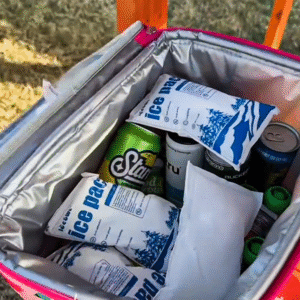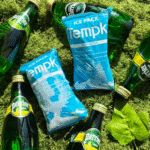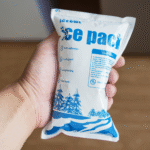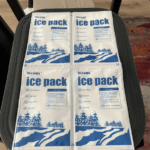No setor de logística da cadeia de frio, maintaining the required temperature for sensitive goods like pharmaceuticals, frutos do mar, and meats is essential for ensuring product safety. Dry ice bricks and pack sheets are two effective cooling solutions widely used to achieve this. Understanding the differences between these options can help businesses select the right solution for their needs.

-
What are the differences between dry ice bricks and pack sheets?
-
How do dry ice bricks and pack sheets maintain temperature during shipping?
-
Which option is best for different shipping durations and temperatures?
What Are Dry Ice Bricks and Pack Sheets?
Dry Ice Bricks
Dry ice bricks are solid blocks of carbon dioxide that sublimate at -78.5°C, providing a concentrated and long-lasting cooling source. These bricks are ideal for long-duration shipments, such as frozen foods or biological samples that require sustained, temperaturas ultra-baixa.
Folhas de embalagens de gelo seco
Dry ice pack sheets are flexible panels filled with small pellets of dry ice. These are often used for shorter shipments or for packaging products that require chilled, rather than frozen, temperaturas. Their flexibility allows them to conform to various package shapes, offering efficient cooling for goods such as cosmetics or pharmaceuticals.
How Do Dry Ice Bricks and Pack Sheets Perform in the Cold Chain?
Both dry ice bricks and pack sheets work by sublimating, a process where solid CO2 transitions directly to gas, absorbing heat and cooling the surrounding environment. The key differences between these forms lie in their cooling duration and flexibility.
| Recurso | Dry Ice Bricks | Folhas de embalagens de gelo seco |
|---|---|---|
| Duração do resfriamento | 72–120 hours | 24–48 horas |
| Flexibilidade | Rígido, less adaptable | Flexível, conforms to shapes |
| Cooling Type | Ultra-frozen | Refrigerado (2° C - 8 ° C.) |
| Ideal Applications | Remessas de longa duração | Short to medium-duration shipments |
Real-World Application:
Por exemplo, vaccines requiring transport at ultra-low temperatures for up to 96 hours benefit from dry ice bricks, whereas fresh pharmaceuticals needing a controlled temperature range for up to 48 hours can be efficiently transported with dry ice pack sheets.
Melhores práticas para usar gelo seco no envio
Embalagem adequada & Isolamento
To optimize the performance of dry ice, use high-quality insulated packaging like Styrofoam or vacuum-insulated panels. Ensure containers are vented to allow CO2 gas to escape and prevent pressure buildup, which could damage the shipment.
How Much Dry Ice to Use?
Para uma remessa de 24 horas, usar aproximadamente 0.5 kg of dry ice per kg of product weight. For shipments lasting longer than 48 horas, increase the quantity of dry ice to account for the sublimation rate. For longer trips, dry ice bricks are recommended due to their extended sublimation time.
Dry Ice Bricks vs. Pack Sheets: O que é melhor para suas necessidades?
Dry Ice Bricks
Ideal for long shipments where products need to remain frozen for several days. They have higher upfront costs but offer longer-lasting cooling and higher capacity, making them essential for high-value, temperature-sensitive goods such as biologics or frozen food.
Folhas de embalagens de gelo seco
Best for short-haul deliveries or when products require a chilled environment. They are cost-effective and flexible, fitting well around smaller packages. No entanto, they do not last as long as dry ice bricks, making them less suitable for long shipments.
Impacto ambiental e sustentabilidade
As the cold chain logistics industry moves toward more sustainable practices, the production of dry ice from CO2 captured during industrial processes has gained traction. This practice reduces reliance on fossil fuels and lowers carbon footprints. Adicionalmente, innovations in packaging and monitoring technology are helping reduce waste and enhance the efficiency of dry ice use.
Sustainability Trends for 2025:
-
Embalagens ecológicas Usando materiais recicláveis e biodegradáveis
-
Smart temperature sensors for real-time monitoring to reduce waste
-
Closed-loop dry ice recycling sistemas, allowing dry ice to be reused
Perguntas frequentes (Perguntas frequentes)
Q1: Quanto tempo dura o gelo seco durante o envio?
Dry ice typically lasts between 24 para 72 horas, depending on the form (bricks or sheets), isolamento, e condições de envio.
Q2: Is dry ice safe for shipping?
Sim, dry ice is safe for shipping when handled properly. Always use vented containers and follow safety guidelines to prevent CO2 buildup.
Q3: How do I calculate the amount of dry ice I need?
Usar 0.5 kg of dry ice per kg of product for a 24-hour shipment. Para durações mais longas, aumente o valor de acordo.
Conclusão e recomendações
Dry ice bricks and pack sheets are both essential tools in cold chain logistics, cada um adequado para diferentes tipos de remessas. By understanding their differences and adhering to best practices, Você pode garantir o transporte seguro e eficiente de bens sensíveis à temperatura.
PRÓXIMOS PASSOS:
-
Assess your shipment’s duration and temperature requirements to choose between bricks or sheets.
-
Invest in high-quality insulated packaging for better temperature control.
-
Fique atualizado em 2025 sustainability trends and smart monitoring systems to improve your logistics operations.
Sobre Tempk
Tempk specializes in innovative cold chain solutions, including dry ice bricks and pack sheets. Our products ensure the safe and efficient transport of temperature-sensitive goods with a focus on sustainability and compliance with industry regulations.
Ready to optimize your cold chain logistics?
Contact Tempk for expert advice on the best dry ice solutions for your needs!























